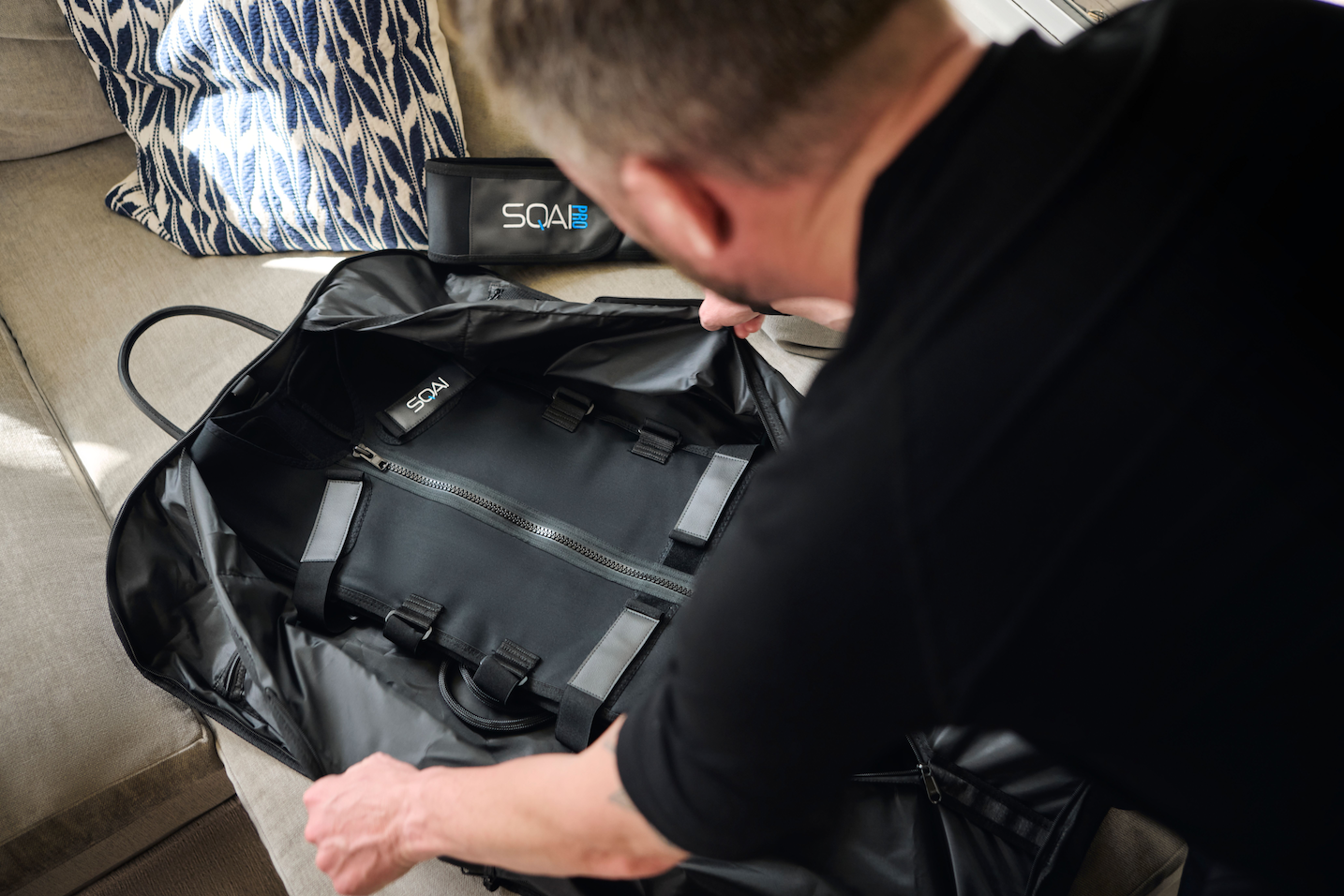In the world of athletics, whether you're a professional competitor or a weekend warrior, one of the biggest challenges after intense training or competition is recovery. Proper recovery is crucial for preventing injury, improving performance, and ensuring that muscles heal effectively. While there are numerous recovery techniques, one that has gained significant attention is Electro Muscle Stimulation (EMS).
EMS has become a popular tool for athletes and fitness enthusiasts, offering a unique way to reduce recovery time and boost overall performance. But how exactly does it work? And can it really help reduce downtime after intense training? Let’s explore the science behind EMS and its impact on sports recovery.
EMS involves the use of electrical impulses to stimulate muscles, mimicking the body’s natural signals that trigger muscle contractions. This stimulation can be applied through electrodes placed on the skin, targeting specific muscle groups. While EMS has long been used in physical therapy to aid in muscle rehabilitation, it has recently found its place in sports recovery.

How EMS Helps With Sports Recovery
Increased Blood Circulation
EMS works by sending electrical impulses that cause muscles to contract and relax. This repetitive contraction mimics the natural muscle movement during exercise, stimulating blood flow to the targeted area. Increased circulation helps to deliver more oxygen and nutrients to the muscles, while also helping to remove metabolic waste products like lactic acid, which accumulate after intense exercise. This process speeds up the natural recovery process and helps reduce muscle soreness.
Reduction of Muscle Soreness
Delayed onset muscle soreness (DOMS) is a common issue after intense training, especially if muscles are pushed beyond their usual limits. The microtears in muscle fibers that occur during exercise lead to inflammation and soreness in the following days. EMS has been shown to help reduce this discomfort by improving circulation and promoting the repair of muscle tissue. EMS treatments can also assist in the removal of waste products that contribute to soreness, offering athletes a quicker recovery period.
Muscle Relaxation and Tension Relief
After a demanding workout or competition, muscles can become tight and tense. EMS can help alleviate this by stimulating muscle contractions that help to reduce muscle stiffness and improve flexibility. The rhythmical contractions and relaxations induced by EMS help to relax the muscles and reduce the risk of injury due to tension or tightness.
Prevention of Muscle Atrophy
Following intense training, the body requires time to rebuild muscle tissue. EMS can be used to stimulate muscles during recovery periods, preventing muscle atrophy (wasting). This is particularly beneficial for athletes who need to take rest days or those recovering from injury. EMS helps maintain muscle strength and endurance by ensuring that muscles are regularly activated, even during periods of rest.
Enhanced Lymphatic Drainage
EMS can stimulate the lymphatic system, which is responsible for removing toxins and excess fluids from the body. By increasing the efficiency of lymphatic drainage, EMS helps reduce swelling and inflammation in the muscles, speeding up the overall recovery process. This is especially important for athletes who suffer from swollen muscles or joints after intense physical activity.
Targeted Recovery
One of the key advantages of EMS over other recovery methods is its ability to target specific muscle groups. This precision makes EMS ideal for athletes who need to recover from localized muscle strain or injury. By applying EMS directly to the affected area, athletes can expedite healing and prevent long-term damage. For example, a runner who experiences calf muscle tightness can use EMS to target that specific muscle and promote faster recovery.
The Science Behind EMS and Muscle Recovery
Numerous studies have highlighted the effectiveness of EMS in promoting muscle recovery. A 2017 study published in the Journal of Strength and Conditioning Research found that EMS significantly reduced muscle soreness and improved muscle performance after intense exercise. Another study published in the European Journal of Applied Physiology concluded that EMS was effective in enhancing muscle recovery by improving blood circulation and reducing inflammation.
While the exact mechanisms behind EMS are still being explored, it is clear that this technology offers tangible benefits for athletes in terms of both performance and recovery. By mimicking the natural muscle contraction process, EMS helps to accelerate recovery while also enhancing muscle strength and flexibility.

Using EMS for Sports Recovery: Best Practices
To maximize the benefits of EMS for recovery, it’s essential to use the technology correctly. Here are a few tips for athletes looking to incorporate EMS into their recovery routine:
Timing is Key
The best time to use EMS for recovery is within 24 to 48 hours after intense exercise. This is when muscles are most likely to experience soreness and inflammation. EMS can help alleviate these symptoms and enhance the recovery process during this critical window.
Target Specific Areas
EMS is most effective when it’s used to target specific muscle groups that are sore or fatigued. By focusing on these areas, EMS can accelerate recovery and prevent further damage to the muscles.
Use as Part of a Holistic Recovery Plan
EMS is not a replacement for traditional recovery methods, such as rest, hydration, nutrition, and stretching. Rather, it should be used in combination with these techniques to provide a well-rounded recovery routine.
Start Slowly
If you're new to EMS, start with lower intensity levels to allow your muscles to adapt to the stimulation. Gradually increase the intensity as you become more comfortable with the device.
Consult a Professional
If you're using EMS to recover from an injury or specific muscle issue, it's a good idea to consult with a healthcare professional, such as a physiotherapist, to ensure that EMS is appropriate for your situation.

EMS vs. Traditional Recovery Methods: A Comparative Look
When it comes to sports recovery, there are various methods available, from traditional techniques like stretching and foam rolling to more modern approaches like cryotherapy and infrared therapy. Each has its benefits, but EMS stands out in several key ways.
Speed of Recovery
Traditional recovery methods, such as stretching, foam rolling, or even passive rest, are vital for muscle recovery, but they can take time to show results. Stretching, for example, helps improve flexibility but doesn’t necessarily reduce inflammation or enhance circulation. EMS, on the other hand, directly stimulates muscle contractions, promoting faster blood flow and more immediate relief from soreness and stiffness. This makes it an ideal option when you're pressed for time and need to recover quickly.
Targeted Treatment
While foam rolling and massage can help with muscle tightness, they may not offer the precise targeting that EMS does. EMS can focus on specific muscles or muscle groups, ensuring that the exact area in need of recovery is addressed. Whether it’s the hamstrings after a long run or the calves after an intense workout, EMS can provide relief where it's needed most.
Ease of Use
Traditional recovery methods often require a physical therapist, a massage therapist, or a lot of personal effort (e.g., foam rolling or stretching). EMS, however, can be used on your own, at home or on the go, with a simple device. This makes it a convenient and efficient option for athletes with busy schedules or those looking to take control of their recovery process.
Combining Methods
While EMS can be highly effective, it’s often best used in conjunction with other recovery methods. For example, combining EMS with hydration, proper nutrition, and light stretching can help create a comprehensive recovery plan. The synergy between EMS and other techniques can yield even better results.
EMS for Injury Recovery and Prevention
Another key benefit of EMS in sports recovery is its role in injury prevention and rehabilitation. Athletes are particularly susceptible to injuries due to the physical demands placed on their bodies. EMS provides several advantages when it comes to injury prevention and recovery:
Rehabilitation After Injury
EMS can be used as part of a rehabilitation program for athletes recovering from injuries like sprains, strains, or ligament damage. It helps stimulate muscle activity around the injury site, promoting faster healing and muscle strength. Physiotherapists often recommend EMS to reduce muscle atrophy in injured athletes, as it maintains muscle stimulation while the athlete is limited in movement.
Preventing Overuse Injuries
Overuse injuries, like tendinitis or stress fractures, are common among athletes who engage in high-intensity training. EMS can aid in muscle recovery by reducing inflammation and improving circulation, helping to prevent overuse injuries. By stimulating muscles regularly, EMS ensures that muscles remain strong and flexible, which reduces the risk of strain and injury during future training sessions.
Strengthening Weak Muscles
Often, certain muscles may be weaker or less active than others, leading to imbalances that contribute to injury. EMS can target weak muscles and activate them, strengthening these areas and reducing the risk of muscle imbalances that could lead to injury over time.

The Role of EMS in Mental Recovery and Performance Enhancement
While the physical benefits of EMS for recovery are clear, many athletes also experience mental recovery benefits. Recovery is not just about physical repair – it's also about ensuring that the mind is rested and ready for the next training session or competition.
Relaxation and Stress Relief
The physical stimulation provided by EMS can help the body release endorphins, the body’s natural “feel-good” hormones. This can result in a sense of relaxation and a reduction in stress levels. For athletes who experience mental fatigue or high levels of stress from intense training, EMS can provide much-needed relaxation and mental clarity.
Improved Sleep Quality
Recovery is not just about physical recovery during the day but also how well athletes sleep. Sleep plays a critical role in muscle repair, hormone regulation, and mental recovery. EMS has been shown to improve sleep quality, particularly for athletes who experience trouble resting due to pain, muscle tension, or high stress. By promoting muscle relaxation and reducing discomfort, EMS can help athletes achieve a deeper, more restorative sleep.
Boosting Motivation and Focus
When muscles are sore and fatigued, motivation can take a hit. By reducing muscle discomfort and improving recovery time, EMS allows athletes to feel better and get back to their training faster. This can help athletes maintain consistent focus and motivation, ensuring they remain on track with their training goals.
EMS Technology for Home Use: Accessibility and Convenience
One of the main advantages of EMS is that it can be used in the comfort of your home, allowing athletes to recover without the need for professional assistance. Many EMS devices are now available for personal use, with portable options designed for convenience and ease of use.
Portable and Easy to Use
Modern EMS units are lightweight, compact, and simple to use. Most devices come with adjustable intensity levels, pre-set programs for different recovery goals, and are designed to be used on various muscle groups. Whether you’re at home, in the gym, or even traveling, you can incorporate EMS into your recovery routine with minimal disruption.
Affordability
Professional EMS treatments at physical therapy clinics can be expensive, and repeated visits can quickly add up. Investing in a personal EMS device offers a cost-effective alternative, providing long-term benefits at a fraction of the cost. Many devices are available at different price points, making them accessible to a wide range of athletes and fitness enthusiasts.
Customizable Programs
One of the greatest advantages of using EMS at home is the ability to customize the treatment. Many devices come with multiple settings that allow athletes to adjust the intensity, frequency, and duration of the treatment to match their specific recovery needs. This level of personalization ensures that athletes can tailor the EMS experience to meet their unique muscle recovery requirements.

The Future of EMS in Sports Recovery
EMS technology continues to evolve, and its applications in sports recovery are expanding. As technology improves, we can expect more sophisticated devices that provide more precise stimulation, with better targeting and more efficient muscle recovery protocols.
Integration with Other Technologies
Future advancements may see EMS devices integrating with other technologies like wearables, fitness trackers, or even artificial intelligence (AI). This could lead to more personalized recovery programs based on real-time data, allowing athletes to fine-tune their recovery routines for optimal performance.
More Accessible and Affordable
As demand for EMS grows, manufacturers will continue to innovate and improve the affordability of these devices. With more options available at various price points, athletes of all levels will have access to EMS recovery tools that can enhance their performance and recovery.
Increased Acceptance in Mainstream Sports
While EMS has gained popularity in professional sports and rehabilitation, its use will continue to increase among recreational athletes and fitness enthusiasts. As more people become aware of the benefits, EMS will likely become a mainstream recovery tool for anyone looking to optimize their athletic performance.

Accelerating Recovery with EMS
EMS is proving to be a revolutionary tool for sports recovery, offering a range of benefits from muscle relaxation and soreness reduction to faster recovery times and enhanced performance. By using EMS technology, athletes can take control of their recovery and minimize downtime between training sessions, ensuring they stay at the peak of their game.
Whether you’re looking to recover faster after intense training or prevent injuries, incorporating EMS into your recovery routine could provide the competitive edge you need. With its numerous advantages, EMS is a valuable asset for athletes of all levels, helping to ensure that you perform at your best, day in and day out.

